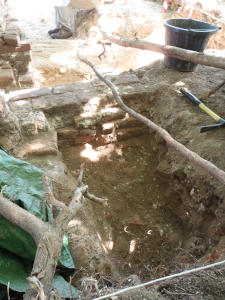24 Jul 2019
Forty Hall Summer Dig - Day 9

Another day of very opressive heat meant slow but steady progress in Forty Hall today as we continued this year's exploration of the 'Long Barn' of the Tudor palace of Elsyng.
Fortunately most of the heaviest work removing indurated layers of brickearth and gravel were finished today, leaving relatively easier tasks to do, mostly in the shade of the park's lime tree avenue.
Yesterday, at the west end of trench 2, we found a very unusual feature set against the barn wall in the form of a conical depression, lined with heat damaged bricks, and containing a layer of ash and charcoal. Although the mortar the feature is set in points to an early/mid fifteenth century date, there appears also to be evidence that the fire pit was incorporated into the later (late 15th/early 16th century) barn, suggesting that it continued to be used.
Exactly what it was used for remains the subject of speculation, particularly why a fire source would have been set into the barn, which we believe was a largely timber-framed structure.

We excavated part of the trench extension which we opened yesterday next to the fire pit, hoping that by revealing more of the area around it we might find more clues as to its function, but have found that the area next to it seems to have been truncated by a rubble filled cut.
What we did find is that the stub of wall next to the pit (which at first we mistook for fragments of a brick floor) is more substatntial than it had at first looked, extending down at least three more courses than were previously visible.
This wall is also a puzzle, since although one end abuts the barn wall, it isn't clear where it runs to.
We haven't excavated enough of the extension along the wall to find this out yet, so this will be a job for tomorrow.

Meanwhile work in trench 1 is essentially complete. The extension to reveal more of the crushed brick deposit showed that it is a wide area of very densely packed brick fragments and brick dust. We excavated a section through it, which showed it to be about 20cm thick and, crucially, that it was filling a shallow depression.
The apparent depression is in precisely the right place to be the remnants of the foundations of the perimeter wall we have been looking for, although evidence elsewhere in the trench may suggest it doesn't follow the exact course we expected.
The only major job in trench 1 now is recording the archaeology before it is backfilled, probably on Friday.

Since the amount of labour required in trenches 1 and 2 has now dropped, we decided to open a third trench today to begin exploring a new research question which arose after last year's dig.
Excavation at the far west end of the barn last year revealed a substantial vertically sided drain, running past the barn's north-west corner.
Based partly on topographic and documentary evidence, we suspect that this drain is heading towards what was probably the inner gatehouse which marked the boundary between the outer and inner courtyards of the palace. In fact, it may be the case that rather than a drain, the feature was a water conduit, perhaps supplying the moat which we know from contemporary documents ran in front of the gatehouse and was crossed by a drawbridge.
Location of the inner gatehouse and moat would be a major milestone in the research of the palace, and although we may not achieve it this year, it's good to be making the first steps in that direction.